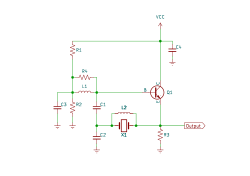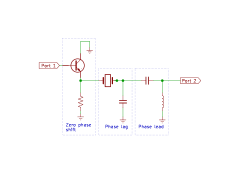Engineering:Butler oscillator
The Butler oscillator is a crystal-controlled oscillator that uses the crystal near its series resonance point. They are used where a simple low-cost circuit is needed which can oscillate at high frquencies (>50MHz[1]) by using overtones of a crystal, and also giving low low phase noise.[2]
It was described by Butler in 1946 as the earthed grid oscillator, a derivative of the Hartley oscillator.[3] It is also known as the bridged-T oscillator or the grounded-base oscillator.[4]
Circuit operation
The classic Butler oscillator circuit is a two-stage circuit with two non-inverting stages, a grounded base stage and an emitter follower.[5] The crystal is inserted in series in the overall feedback path.[5]
The more common modern form of the circuit uses just the emitter follower stage.[1][6] The circuit may be analysed by considering it as a equivalent AC circuit with three parts. The emitter follower forms an amplifier with no phase shift. The crystal and its loading capacitor then produce a phase lag network, followed by the LC network of the resonant tank circuit. This then produces a phase lead, which overall meets the Barkhausen criteria for self-oscillation.[1]
The Butler circuit is a free-running or tuned oscillator. If the crystal is replaced temporarily with a low value resistor, the circuit will still oscillate at approximately the design frequency of the tank circuit. This allows the circuit to be set-up and adjusted initially without the crystal, and also encourages the selection of the correct crystal harmonic.[6] To avoid the circuit oscillating at the strong resonance of the crystal's fundamental, a small inductor may be placed in parallel with the crystal.[1][6]
Both the better-known Pierce and Colpitts oscillator circuits may be considered as derivatives of the Butler.[6][lower-roman 1]
References
- ↑ In the sense of circuit analysis, rather than historical origin.
- ↑ 1.0 1.1 1.2 1.3 "Butler Crystal Oscillator Design". Understanding Quartz Crystals and Oscillators. pp. 237–247. https://www.mikrocontroller.net/attachment/499019/Butler_OT_XO.pdf.
- ↑ Cushing, Richard; Swift, Steven. "A Discrete, Low Phase Noise, 125 MHz Crystal Oscillator for the AD9850 Complete Direct Digital Synthesizer". Analog Devices. http://www.analog.com/static/imported-files/application_notes/AN-419.pdf.
- ↑ Butler, F. (June 1946). "Series-Resonant Crystal Oscillators". Wireless Engineer 23: 157–160.
- ↑ Karlquist, Richard (January 1999), A New Type of Balanced-Bridge Controlled Oscillator, Hewlett-Packard, HPL-1999-6, http://www.hpl.hp.com/techreports/1999/HPL-1999-6.pdf Butler, Meacham, Sultzer, ...
- ↑ 5.0 5.1 Gottlieb, Irving M. (1997), Practical Oscillator Handbook, Newnes, pp. 164–165, ISBN 0-7506-3102-3, https://books.google.com/books?id=e_oZ69GAuxAC&q=butler+oscillator&pg=PA164
- ↑ 6.0 6.1 6.2 6.3 "Crystal Theory". Somerset UK: EuroQuartz. http://www.euroquartz.co.uk/portals/0/pdf/tech-notes.pdf.
Further reading
- Carr, Joe (September 1999), "Crystals Made Clear I", Electronics World: 780–783
- Carr, Joe (October 1999), "Crystals Made Clear II", Electronics World: 849–855
- Sibrai, Andreas & Kurt Fritzwenwallner, "High quality serial resonance oscillator", US patent 6741137, published 6 January 2003, issued 25 May 2004
- Feistel, Claude Herbert & Theodore Gianos, "Butler oscillator", US patent 3996530, published June 30, 1975, issued Dec 7, 1976, assigned to International Business Machines Corporation
External links
- Two-transistor Butler
- "Technicana: Series Resonant Crystal Oscillators", Radio Manufacturing and Broadcasting: 6–7, October 1946, http://www.americanradiohistory.com/Archive-Radio/40s/Radio-1946-10.pdf
 |



